HC2091 - Bega Cheese Company: Financial Analysis for Investment
VerifiedAdded on 2023/03/23
|20
|4970
|82
Report
AI Summary
This report provides a comprehensive financial analysis of Bega Cheese, an ASX-listed dairy company, examining its profitability, operational efficiency, and investment potential. It includes a description of the company's values and financial activities, an analysis of key financial ratios such as profitability and operational efficiency, and a comparison of share price movements over the past two years. The report also calculates the cost of equity and WACC to inform investment decisions. The analysis reveals fluctuations in the company's stock price and a decline in net profit margin, leading to a recommendation against short-term investment due to the company's unstable financial position. The report concludes with detailed recommendations and references, offering a thorough evaluation of Bega Cheese's financial health for potential investors. Desklib provides access to similar reports and solved assignments for students.
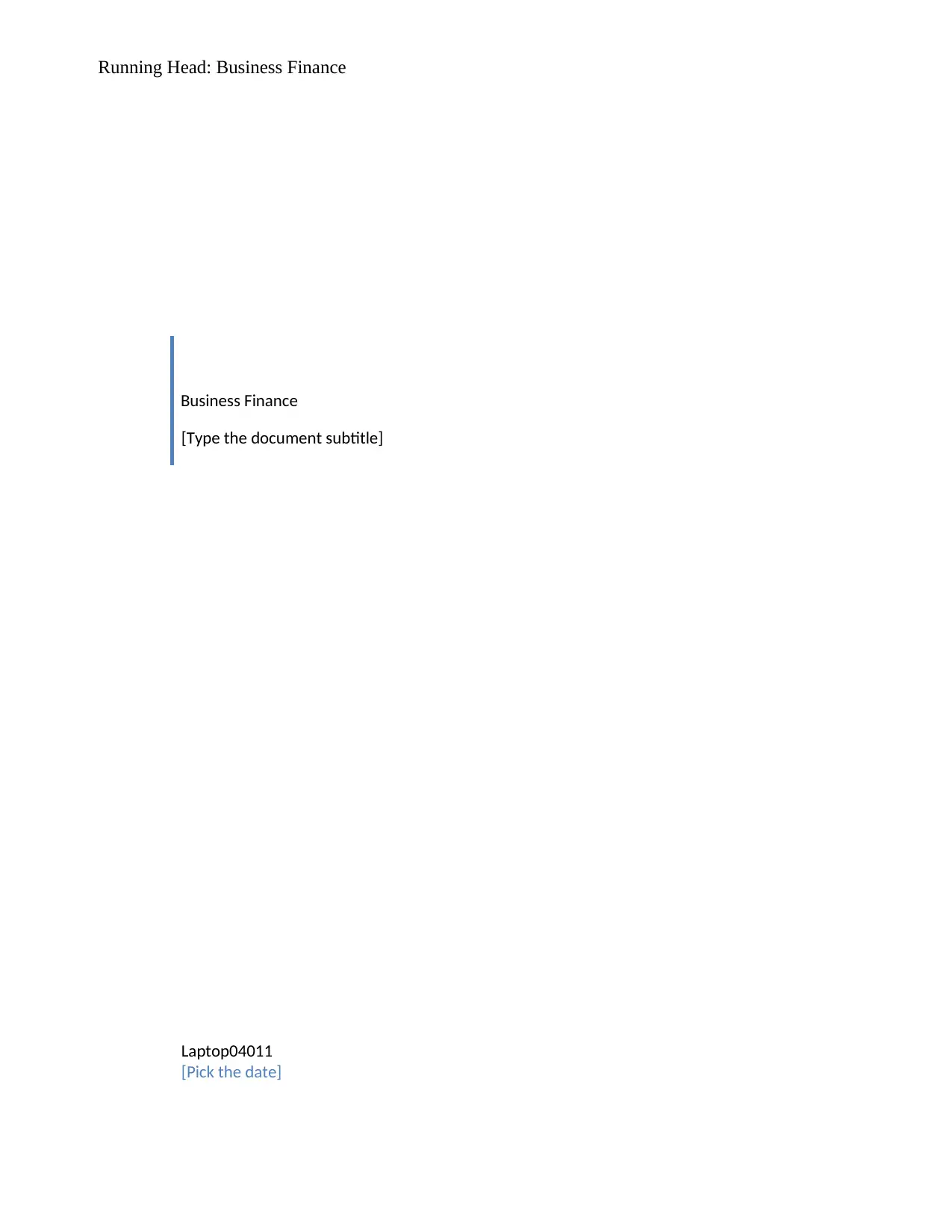
Running Head: Business Finance
Business Finance
[Type the document subtitle]
Laptop04011
[Pick the date]
Business Finance
[Type the document subtitle]
Laptop04011
[Pick the date]
Paraphrase This Document
Need a fresh take? Get an instant paraphrase of this document with our AI Paraphraser
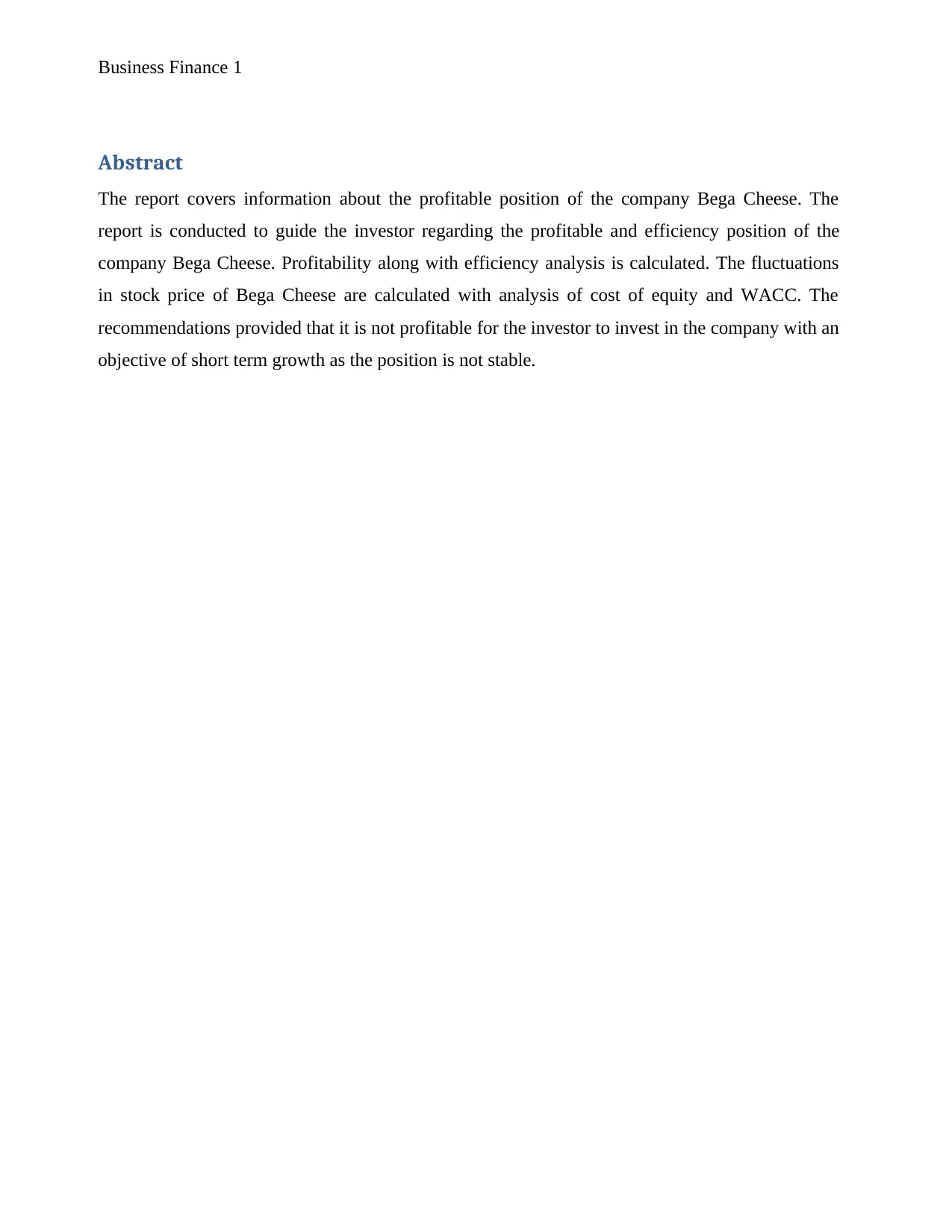
Business Finance 1
Abstract
The report covers information about the profitable position of the company Bega Cheese. The
report is conducted to guide the investor regarding the profitable and efficiency position of the
company Bega Cheese. Profitability along with efficiency analysis is calculated. The fluctuations
in stock price of Bega Cheese are calculated with analysis of cost of equity and WACC. The
recommendations provided that it is not profitable for the investor to invest in the company with an
objective of short term growth as the position is not stable.
Abstract
The report covers information about the profitable position of the company Bega Cheese. The
report is conducted to guide the investor regarding the profitable and efficiency position of the
company Bega Cheese. Profitability along with efficiency analysis is calculated. The fluctuations
in stock price of Bega Cheese are calculated with analysis of cost of equity and WACC. The
recommendations provided that it is not profitable for the investor to invest in the company with an
objective of short term growth as the position is not stable.

Business Finance 2
Contents
Introduction.........................................................................................................................................1
Financial Analysis of Bega Cheese....................................................................................................1
Description about Bega Cheese......................................................................................................1
Analysis of Financial Ratios...........................................................................................................2
Profitability Ratio Evaluation.........................................................................................................2
Operation Efficiency Ratio Evaluation...........................................................................................3
Comparison of share price movements...........................................................................................5
Cost of Equity and Identification of Capital Structure...................................................................6
Conclusion..........................................................................................................................................7
Recommendation................................................................................................................................8
References...........................................................................................................................................9
Appendices.......................................................................................................................................11
Contents
Introduction.........................................................................................................................................1
Financial Analysis of Bega Cheese....................................................................................................1
Description about Bega Cheese......................................................................................................1
Analysis of Financial Ratios...........................................................................................................2
Profitability Ratio Evaluation.........................................................................................................2
Operation Efficiency Ratio Evaluation...........................................................................................3
Comparison of share price movements...........................................................................................5
Cost of Equity and Identification of Capital Structure...................................................................6
Conclusion..........................................................................................................................................7
Recommendation................................................................................................................................8
References...........................................................................................................................................9
Appendices.......................................................................................................................................11
⊘ This is a preview!⊘
Do you want full access?
Subscribe today to unlock all pages.

Trusted by 1+ million students worldwide
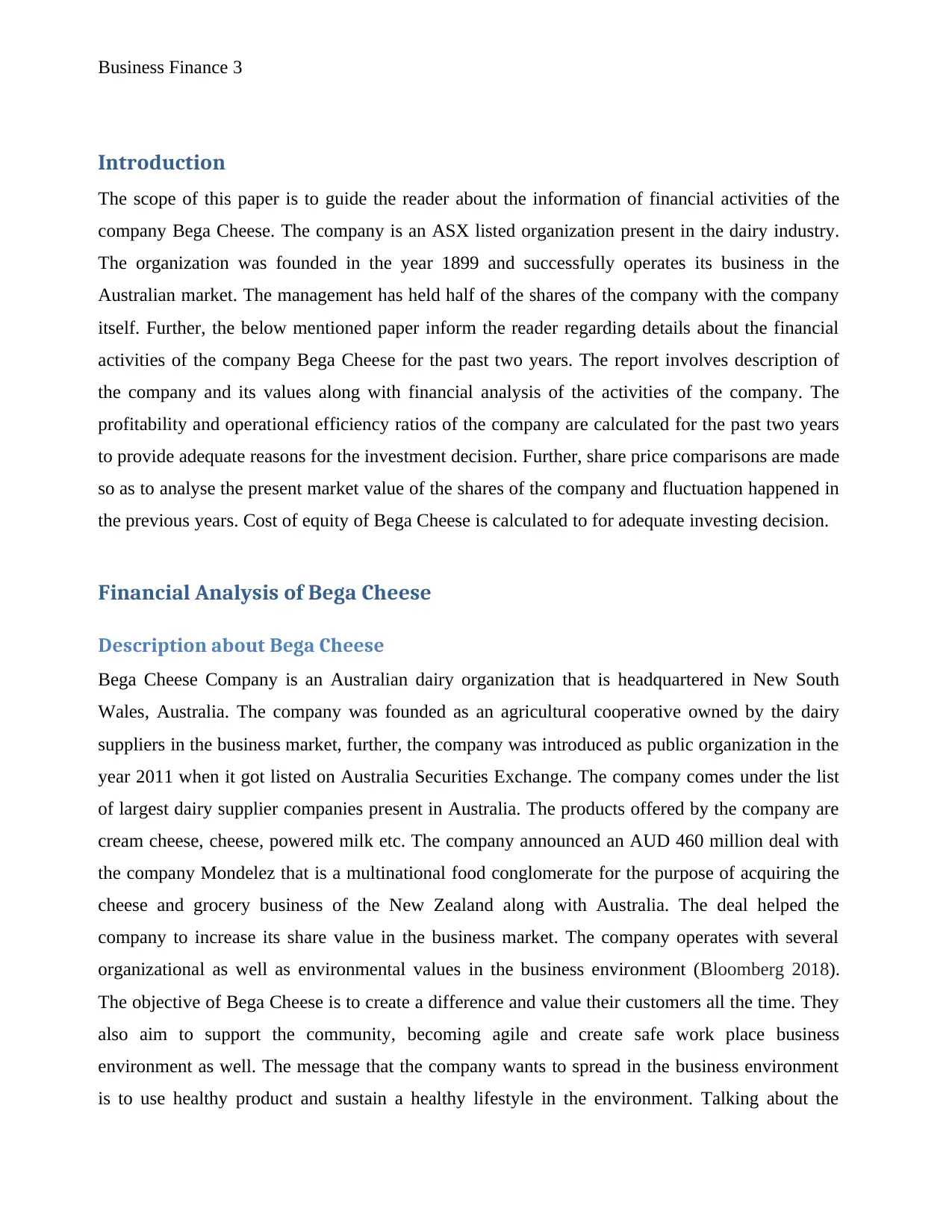
Business Finance 3
Introduction
The scope of this paper is to guide the reader about the information of financial activities of the
company Bega Cheese. The company is an ASX listed organization present in the dairy industry.
The organization was founded in the year 1899 and successfully operates its business in the
Australian market. The management has held half of the shares of the company with the company
itself. Further, the below mentioned paper inform the reader regarding details about the financial
activities of the company Bega Cheese for the past two years. The report involves description of
the company and its values along with financial analysis of the activities of the company. The
profitability and operational efficiency ratios of the company are calculated for the past two years
to provide adequate reasons for the investment decision. Further, share price comparisons are made
so as to analyse the present market value of the shares of the company and fluctuation happened in
the previous years. Cost of equity of Bega Cheese is calculated to for adequate investing decision.
Financial Analysis of Bega Cheese
Description about Bega Cheese
Bega Cheese Company is an Australian dairy organization that is headquartered in New South
Wales, Australia. The company was founded as an agricultural cooperative owned by the dairy
suppliers in the business market, further, the company was introduced as public organization in the
year 2011 when it got listed on Australia Securities Exchange. The company comes under the list
of largest dairy supplier companies present in Australia. The products offered by the company are
cream cheese, cheese, powered milk etc. The company announced an AUD 460 million deal with
the company Mondelez that is a multinational food conglomerate for the purpose of acquiring the
cheese and grocery business of the New Zealand along with Australia. The deal helped the
company to increase its share value in the business market. The company operates with several
organizational as well as environmental values in the business environment (Bloomberg 2018).
The objective of Bega Cheese is to create a difference and value their customers all the time. They
also aim to support the community, becoming agile and create safe work place business
environment as well. The message that the company wants to spread in the business environment
is to use healthy product and sustain a healthy lifestyle in the environment. Talking about the
Introduction
The scope of this paper is to guide the reader about the information of financial activities of the
company Bega Cheese. The company is an ASX listed organization present in the dairy industry.
The organization was founded in the year 1899 and successfully operates its business in the
Australian market. The management has held half of the shares of the company with the company
itself. Further, the below mentioned paper inform the reader regarding details about the financial
activities of the company Bega Cheese for the past two years. The report involves description of
the company and its values along with financial analysis of the activities of the company. The
profitability and operational efficiency ratios of the company are calculated for the past two years
to provide adequate reasons for the investment decision. Further, share price comparisons are made
so as to analyse the present market value of the shares of the company and fluctuation happened in
the previous years. Cost of equity of Bega Cheese is calculated to for adequate investing decision.
Financial Analysis of Bega Cheese
Description about Bega Cheese
Bega Cheese Company is an Australian dairy organization that is headquartered in New South
Wales, Australia. The company was founded as an agricultural cooperative owned by the dairy
suppliers in the business market, further, the company was introduced as public organization in the
year 2011 when it got listed on Australia Securities Exchange. The company comes under the list
of largest dairy supplier companies present in Australia. The products offered by the company are
cream cheese, cheese, powered milk etc. The company announced an AUD 460 million deal with
the company Mondelez that is a multinational food conglomerate for the purpose of acquiring the
cheese and grocery business of the New Zealand along with Australia. The deal helped the
company to increase its share value in the business market. The company operates with several
organizational as well as environmental values in the business environment (Bloomberg 2018).
The objective of Bega Cheese is to create a difference and value their customers all the time. They
also aim to support the community, becoming agile and create safe work place business
environment as well. The message that the company wants to spread in the business environment
is to use healthy product and sustain a healthy lifestyle in the environment. Talking about the
Paraphrase This Document
Need a fresh take? Get an instant paraphrase of this document with our AI Paraphraser

Business Finance 4
revenue highlights, it should be noted that the company earned revenue of $1.44 billion and export
products of $0.43 billion in the external environment. The goal of the organization is to integrate
the activities in the production process effortlessly. Further, the company also aim to increase the
share peanut company of the Australia in the Bega Foods (Bega Cheese 2018). Along with this,
they also aim to increase the amount of peanut crop grown in the country. Talking about the
operations of the company, it is keen to note that the company has considerably increased the
production process in 2018 by 9% than 2017. Also they are aiming to efficiently use ERP system
in the business for effortless internal business activities. In the previous year, Bega Cheese
introduced four new branches of the company at Tolga, Koroit, Kingaroy and Port Melbourne. The
company has also started working on the milk procurement program along with strong
international business growth as well. Lastly, they also aspire to grow as a branded retail and food
service business in the external market (Bega Cheese 2018).
Analysis of Financial Ratios
Profitability Ratio Evaluation
Profitability and Efficiency Ratios 2017 2018
Profitability
Times interest coverage ratio EBIT 10.3 6.0
Interest Expense
Net Profit Net Profit * 100 11% 2%
Net Sales
Asset Turnover Ratio Net Sales 2.32 2.36
Average total Assets
It is important to note that profitability is the most important area of concern for any investor as it
provides a clear picture about the financial growth and long term survival rate of the company. It is
important for an organization to have a considerable amount of earning left with them all the time
after meeting all the costs and expenses. Profitability is something that is achieved after the costs
are deducted from the sales revenue of the company. In order to ascertain a clear image about the
profitability position of the business, the asset turnover ratio, times interest coverage ratio and net
profit ratio are calculated by the company. It should be noted that the interest coverage ratio of the
revenue highlights, it should be noted that the company earned revenue of $1.44 billion and export
products of $0.43 billion in the external environment. The goal of the organization is to integrate
the activities in the production process effortlessly. Further, the company also aim to increase the
share peanut company of the Australia in the Bega Foods (Bega Cheese 2018). Along with this,
they also aim to increase the amount of peanut crop grown in the country. Talking about the
operations of the company, it is keen to note that the company has considerably increased the
production process in 2018 by 9% than 2017. Also they are aiming to efficiently use ERP system
in the business for effortless internal business activities. In the previous year, Bega Cheese
introduced four new branches of the company at Tolga, Koroit, Kingaroy and Port Melbourne. The
company has also started working on the milk procurement program along with strong
international business growth as well. Lastly, they also aspire to grow as a branded retail and food
service business in the external market (Bega Cheese 2018).
Analysis of Financial Ratios
Profitability Ratio Evaluation
Profitability and Efficiency Ratios 2017 2018
Profitability
Times interest coverage ratio EBIT 10.3 6.0
Interest Expense
Net Profit Net Profit * 100 11% 2%
Net Sales
Asset Turnover Ratio Net Sales 2.32 2.36
Average total Assets
It is important to note that profitability is the most important area of concern for any investor as it
provides a clear picture about the financial growth and long term survival rate of the company. It is
important for an organization to have a considerable amount of earning left with them all the time
after meeting all the costs and expenses. Profitability is something that is achieved after the costs
are deducted from the sales revenue of the company. In order to ascertain a clear image about the
profitability position of the business, the asset turnover ratio, times interest coverage ratio and net
profit ratio are calculated by the company. It should be noted that the interest coverage ratio of the
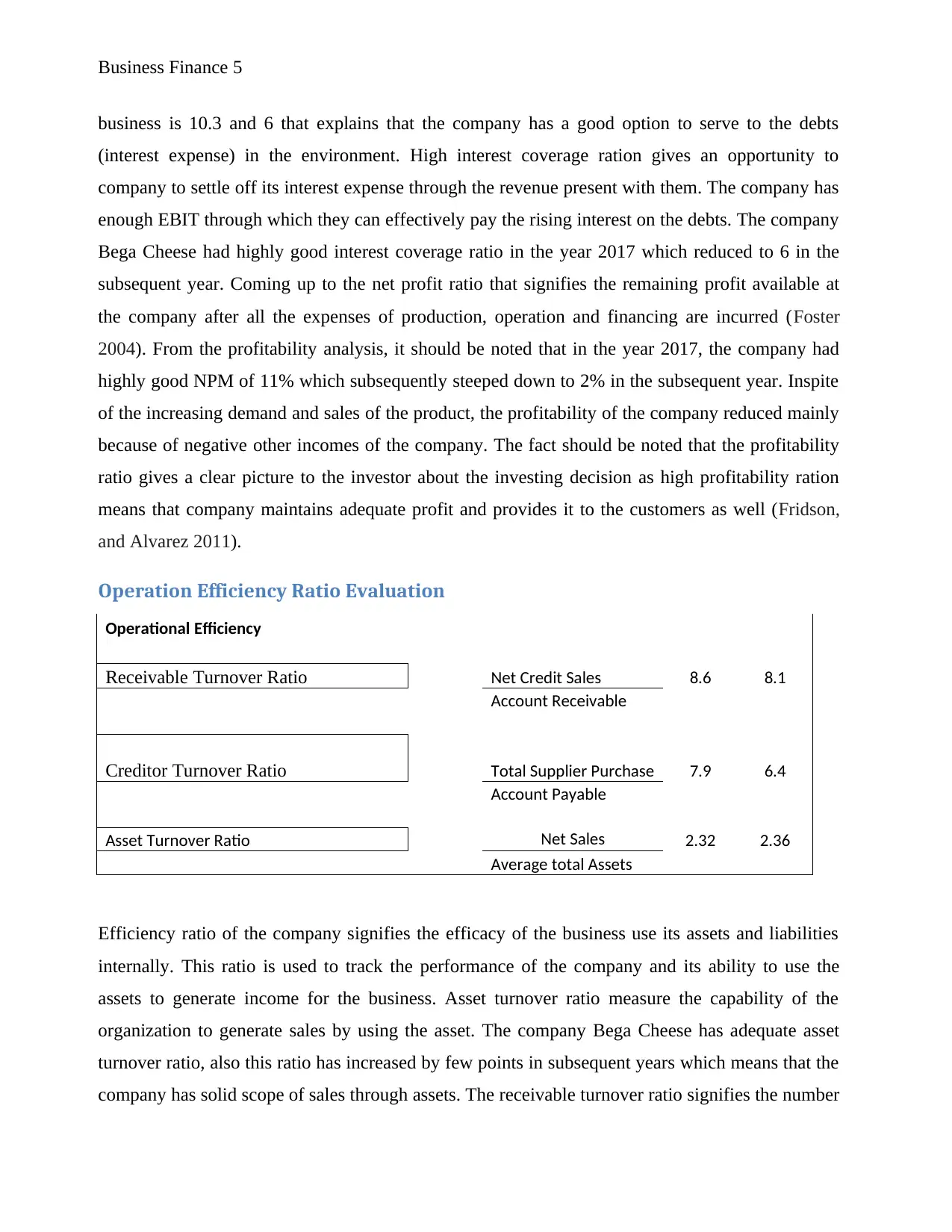
Business Finance 5
business is 10.3 and 6 that explains that the company has a good option to serve to the debts
(interest expense) in the environment. High interest coverage ration gives an opportunity to
company to settle off its interest expense through the revenue present with them. The company has
enough EBIT through which they can effectively pay the rising interest on the debts. The company
Bega Cheese had highly good interest coverage ratio in the year 2017 which reduced to 6 in the
subsequent year. Coming up to the net profit ratio that signifies the remaining profit available at
the company after all the expenses of production, operation and financing are incurred (Foster
2004). From the profitability analysis, it should be noted that in the year 2017, the company had
highly good NPM of 11% which subsequently steeped down to 2% in the subsequent year. Inspite
of the increasing demand and sales of the product, the profitability of the company reduced mainly
because of negative other incomes of the company. The fact should be noted that the profitability
ratio gives a clear picture to the investor about the investing decision as high profitability ration
means that company maintains adequate profit and provides it to the customers as well (Fridson,
and Alvarez 2011).
Operation Efficiency Ratio Evaluation
Operational Efficiency
Receivable Turnover Ratio Net Credit Sales 8.6 8.1
Account Receivable
Creditor Turnover Ratio Total Supplier Purchase 7.9 6.4
Account Payable
Asset Turnover Ratio Net Sales 2.32 2.36
Average total Assets
Efficiency ratio of the company signifies the efficacy of the business use its assets and liabilities
internally. This ratio is used to track the performance of the company and its ability to use the
assets to generate income for the business. Asset turnover ratio measure the capability of the
organization to generate sales by using the asset. The company Bega Cheese has adequate asset
turnover ratio, also this ratio has increased by few points in subsequent years which means that the
company has solid scope of sales through assets. The receivable turnover ratio signifies the number
business is 10.3 and 6 that explains that the company has a good option to serve to the debts
(interest expense) in the environment. High interest coverage ration gives an opportunity to
company to settle off its interest expense through the revenue present with them. The company has
enough EBIT through which they can effectively pay the rising interest on the debts. The company
Bega Cheese had highly good interest coverage ratio in the year 2017 which reduced to 6 in the
subsequent year. Coming up to the net profit ratio that signifies the remaining profit available at
the company after all the expenses of production, operation and financing are incurred (Foster
2004). From the profitability analysis, it should be noted that in the year 2017, the company had
highly good NPM of 11% which subsequently steeped down to 2% in the subsequent year. Inspite
of the increasing demand and sales of the product, the profitability of the company reduced mainly
because of negative other incomes of the company. The fact should be noted that the profitability
ratio gives a clear picture to the investor about the investing decision as high profitability ration
means that company maintains adequate profit and provides it to the customers as well (Fridson,
and Alvarez 2011).
Operation Efficiency Ratio Evaluation
Operational Efficiency
Receivable Turnover Ratio Net Credit Sales 8.6 8.1
Account Receivable
Creditor Turnover Ratio Total Supplier Purchase 7.9 6.4
Account Payable
Asset Turnover Ratio Net Sales 2.32 2.36
Average total Assets
Efficiency ratio of the company signifies the efficacy of the business use its assets and liabilities
internally. This ratio is used to track the performance of the company and its ability to use the
assets to generate income for the business. Asset turnover ratio measure the capability of the
organization to generate sales by using the asset. The company Bega Cheese has adequate asset
turnover ratio, also this ratio has increased by few points in subsequent years which means that the
company has solid scope of sales through assets. The receivable turnover ratio signifies the number
⊘ This is a preview!⊘
Do you want full access?
Subscribe today to unlock all pages.

Trusted by 1+ million students worldwide
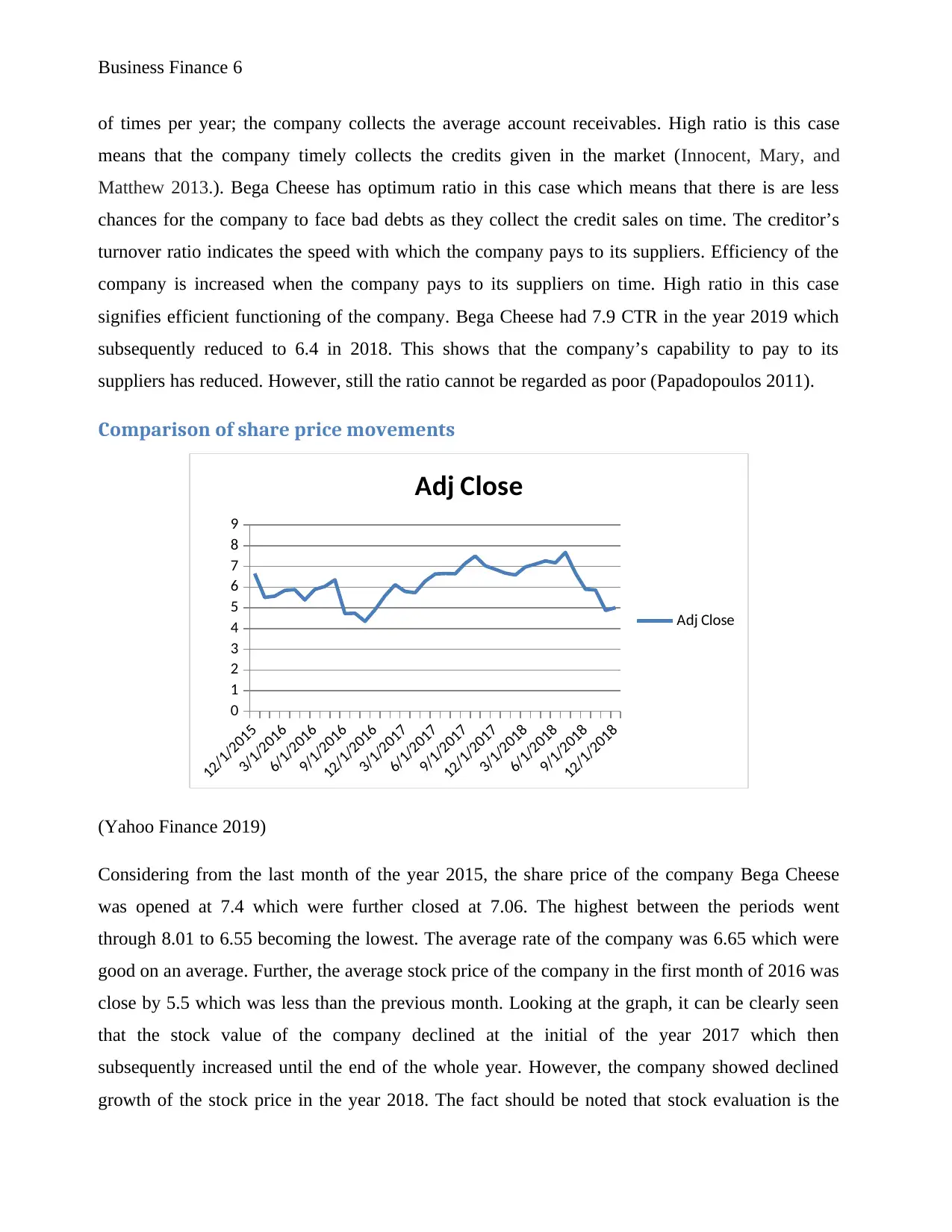
Business Finance 6
of times per year; the company collects the average account receivables. High ratio is this case
means that the company timely collects the credits given in the market (Innocent, Mary, and
Matthew 2013.). Bega Cheese has optimum ratio in this case which means that there is are less
chances for the company to face bad debts as they collect the credit sales on time. The creditor’s
turnover ratio indicates the speed with which the company pays to its suppliers. Efficiency of the
company is increased when the company pays to its suppliers on time. High ratio in this case
signifies efficient functioning of the company. Bega Cheese had 7.9 CTR in the year 2019 which
subsequently reduced to 6.4 in 2018. This shows that the company’s capability to pay to its
suppliers has reduced. However, still the ratio cannot be regarded as poor (Papadopoulos 2011).
Comparison of share price movements
12/1/2015
3/1/2016
6/1/2016
9/1/2016
12/1/2016
3/1/2017
6/1/2017
9/1/2017
12/1/2017
3/1/2018
6/1/2018
9/1/2018
12/1/2018
0
1
2
3
4
5
6
7
8
9
Adj Close
Adj Close
(Yahoo Finance 2019)
Considering from the last month of the year 2015, the share price of the company Bega Cheese
was opened at 7.4 which were further closed at 7.06. The highest between the periods went
through 8.01 to 6.55 becoming the lowest. The average rate of the company was 6.65 which were
good on an average. Further, the average stock price of the company in the first month of 2016 was
close by 5.5 which was less than the previous month. Looking at the graph, it can be clearly seen
that the stock value of the company declined at the initial of the year 2017 which then
subsequently increased until the end of the whole year. However, the company showed declined
growth of the stock price in the year 2018. The fact should be noted that stock evaluation is the
of times per year; the company collects the average account receivables. High ratio is this case
means that the company timely collects the credits given in the market (Innocent, Mary, and
Matthew 2013.). Bega Cheese has optimum ratio in this case which means that there is are less
chances for the company to face bad debts as they collect the credit sales on time. The creditor’s
turnover ratio indicates the speed with which the company pays to its suppliers. Efficiency of the
company is increased when the company pays to its suppliers on time. High ratio in this case
signifies efficient functioning of the company. Bega Cheese had 7.9 CTR in the year 2019 which
subsequently reduced to 6.4 in 2018. This shows that the company’s capability to pay to its
suppliers has reduced. However, still the ratio cannot be regarded as poor (Papadopoulos 2011).
Comparison of share price movements
12/1/2015
3/1/2016
6/1/2016
9/1/2016
12/1/2016
3/1/2017
6/1/2017
9/1/2017
12/1/2017
3/1/2018
6/1/2018
9/1/2018
12/1/2018
0
1
2
3
4
5
6
7
8
9
Adj Close
Adj Close
(Yahoo Finance 2019)
Considering from the last month of the year 2015, the share price of the company Bega Cheese
was opened at 7.4 which were further closed at 7.06. The highest between the periods went
through 8.01 to 6.55 becoming the lowest. The average rate of the company was 6.65 which were
good on an average. Further, the average stock price of the company in the first month of 2016 was
close by 5.5 which was less than the previous month. Looking at the graph, it can be clearly seen
that the stock value of the company declined at the initial of the year 2017 which then
subsequently increased until the end of the whole year. However, the company showed declined
growth of the stock price in the year 2018. The fact should be noted that stock evaluation is the
Paraphrase This Document
Need a fresh take? Get an instant paraphrase of this document with our AI Paraphraser
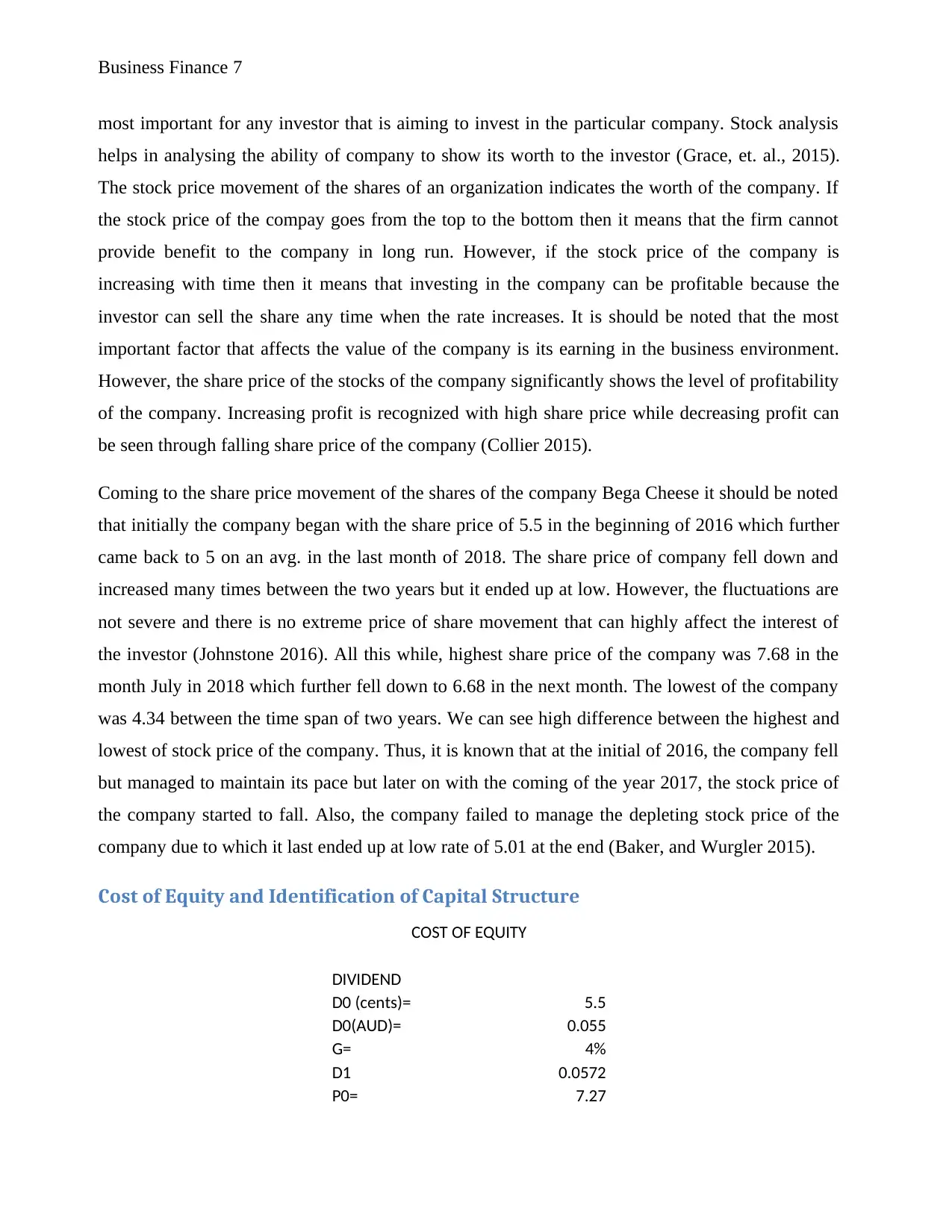
Business Finance 7
most important for any investor that is aiming to invest in the particular company. Stock analysis
helps in analysing the ability of company to show its worth to the investor (Grace, et. al., 2015).
The stock price movement of the shares of an organization indicates the worth of the company. If
the stock price of the compay goes from the top to the bottom then it means that the firm cannot
provide benefit to the company in long run. However, if the stock price of the company is
increasing with time then it means that investing in the company can be profitable because the
investor can sell the share any time when the rate increases. It is should be noted that the most
important factor that affects the value of the company is its earning in the business environment.
However, the share price of the stocks of the company significantly shows the level of profitability
of the company. Increasing profit is recognized with high share price while decreasing profit can
be seen through falling share price of the company (Collier 2015).
Coming to the share price movement of the shares of the company Bega Cheese it should be noted
that initially the company began with the share price of 5.5 in the beginning of 2016 which further
came back to 5 on an avg. in the last month of 2018. The share price of company fell down and
increased many times between the two years but it ended up at low. However, the fluctuations are
not severe and there is no extreme price of share movement that can highly affect the interest of
the investor (Johnstone 2016). All this while, highest share price of the company was 7.68 in the
month July in 2018 which further fell down to 6.68 in the next month. The lowest of the company
was 4.34 between the time span of two years. We can see high difference between the highest and
lowest of stock price of the company. Thus, it is known that at the initial of 2016, the company fell
but managed to maintain its pace but later on with the coming of the year 2017, the stock price of
the company started to fall. Also, the company failed to manage the depleting stock price of the
company due to which it last ended up at low rate of 5.01 at the end (Baker, and Wurgler 2015).
Cost of Equity and Identification of Capital Structure
COST OF EQUITY
DIVIDEND
D0 (cents)= 5.5
D0(AUD)= 0.055
G= 4%
D1 0.0572
P0= 7.27
most important for any investor that is aiming to invest in the particular company. Stock analysis
helps in analysing the ability of company to show its worth to the investor (Grace, et. al., 2015).
The stock price movement of the shares of an organization indicates the worth of the company. If
the stock price of the compay goes from the top to the bottom then it means that the firm cannot
provide benefit to the company in long run. However, if the stock price of the company is
increasing with time then it means that investing in the company can be profitable because the
investor can sell the share any time when the rate increases. It is should be noted that the most
important factor that affects the value of the company is its earning in the business environment.
However, the share price of the stocks of the company significantly shows the level of profitability
of the company. Increasing profit is recognized with high share price while decreasing profit can
be seen through falling share price of the company (Collier 2015).
Coming to the share price movement of the shares of the company Bega Cheese it should be noted
that initially the company began with the share price of 5.5 in the beginning of 2016 which further
came back to 5 on an avg. in the last month of 2018. The share price of company fell down and
increased many times between the two years but it ended up at low. However, the fluctuations are
not severe and there is no extreme price of share movement that can highly affect the interest of
the investor (Johnstone 2016). All this while, highest share price of the company was 7.68 in the
month July in 2018 which further fell down to 6.68 in the next month. The lowest of the company
was 4.34 between the time span of two years. We can see high difference between the highest and
lowest of stock price of the company. Thus, it is known that at the initial of 2016, the company fell
but managed to maintain its pace but later on with the coming of the year 2017, the stock price of
the company started to fall. Also, the company failed to manage the depleting stock price of the
company due to which it last ended up at low rate of 5.01 at the end (Baker, and Wurgler 2015).
Cost of Equity and Identification of Capital Structure
COST OF EQUITY
DIVIDEND
D0 (cents)= 5.5
D0(AUD)= 0.055
G= 4%
D1 0.0572
P0= 7.27

Business Finance 8
As per divident growth model
Pe= D1/(Ke-g)
ke= (D1/P0)+G
4.79%
Cost of equity refers to the return of the company to the investors in order to manage the risk that
they start by financing in their capital in the activities of the company. It is crucial for the business
to attain capital from people and bodies present in the business environment so as to grow and
operate business functions effectively. People that provide their savings to the company when they
need should get additional reward for the risk of investment and the time period for which they
wait (Berger, Chen, and Li 2018). So, cost of equity is the amount of funds that the company
provide to each investor so that their interest is maintained in the company along with the funds.
So, for the company, payment to investor is a cost and they must earn more than the cost of equity
so as to leave unaffected, the market value of shares. With the increase in market price of the
share, the value of cost of equity decreases. In the above mentioned table, the cost of equity of the
company Bega Cheese is calculated using dividend growth model (Tracy 2012).
It is assumed that the rates given are after tax
WACC= Ke*wt. of eq.+Kp*wt. of prf sh+Kd*wt. of debt
Kd 5% 0.016
Kp 0% 0.000
Ke 4.79% 0.032
WACC 4.86%
amounts weight wt. rates
Debt 306 0.33 0.016
Preference
Capital 0 0 0.000
Equity Capital 633 0.67 0.032
Total 939
Further, it should be noted that the capital structure of the company includes debts and equity
capital. The company does not have preference share capital in the business environment and the
capital is divided into AUD 633 million of equity and AUD 584 of debts. The level of debts of
Bega Cheese rose from the previous year while the level of equity decreased. The weighted
As per divident growth model
Pe= D1/(Ke-g)
ke= (D1/P0)+G
4.79%
Cost of equity refers to the return of the company to the investors in order to manage the risk that
they start by financing in their capital in the activities of the company. It is crucial for the business
to attain capital from people and bodies present in the business environment so as to grow and
operate business functions effectively. People that provide their savings to the company when they
need should get additional reward for the risk of investment and the time period for which they
wait (Berger, Chen, and Li 2018). So, cost of equity is the amount of funds that the company
provide to each investor so that their interest is maintained in the company along with the funds.
So, for the company, payment to investor is a cost and they must earn more than the cost of equity
so as to leave unaffected, the market value of shares. With the increase in market price of the
share, the value of cost of equity decreases. In the above mentioned table, the cost of equity of the
company Bega Cheese is calculated using dividend growth model (Tracy 2012).
It is assumed that the rates given are after tax
WACC= Ke*wt. of eq.+Kp*wt. of prf sh+Kd*wt. of debt
Kd 5% 0.016
Kp 0% 0.000
Ke 4.79% 0.032
WACC 4.86%
amounts weight wt. rates
Debt 306 0.33 0.016
Preference
Capital 0 0 0.000
Equity Capital 633 0.67 0.032
Total 939
Further, it should be noted that the capital structure of the company includes debts and equity
capital. The company does not have preference share capital in the business environment and the
capital is divided into AUD 633 million of equity and AUD 584 of debts. The level of debts of
Bega Cheese rose from the previous year while the level of equity decreased. The weighted
⊘ This is a preview!⊘
Do you want full access?
Subscribe today to unlock all pages.

Trusted by 1+ million students worldwide
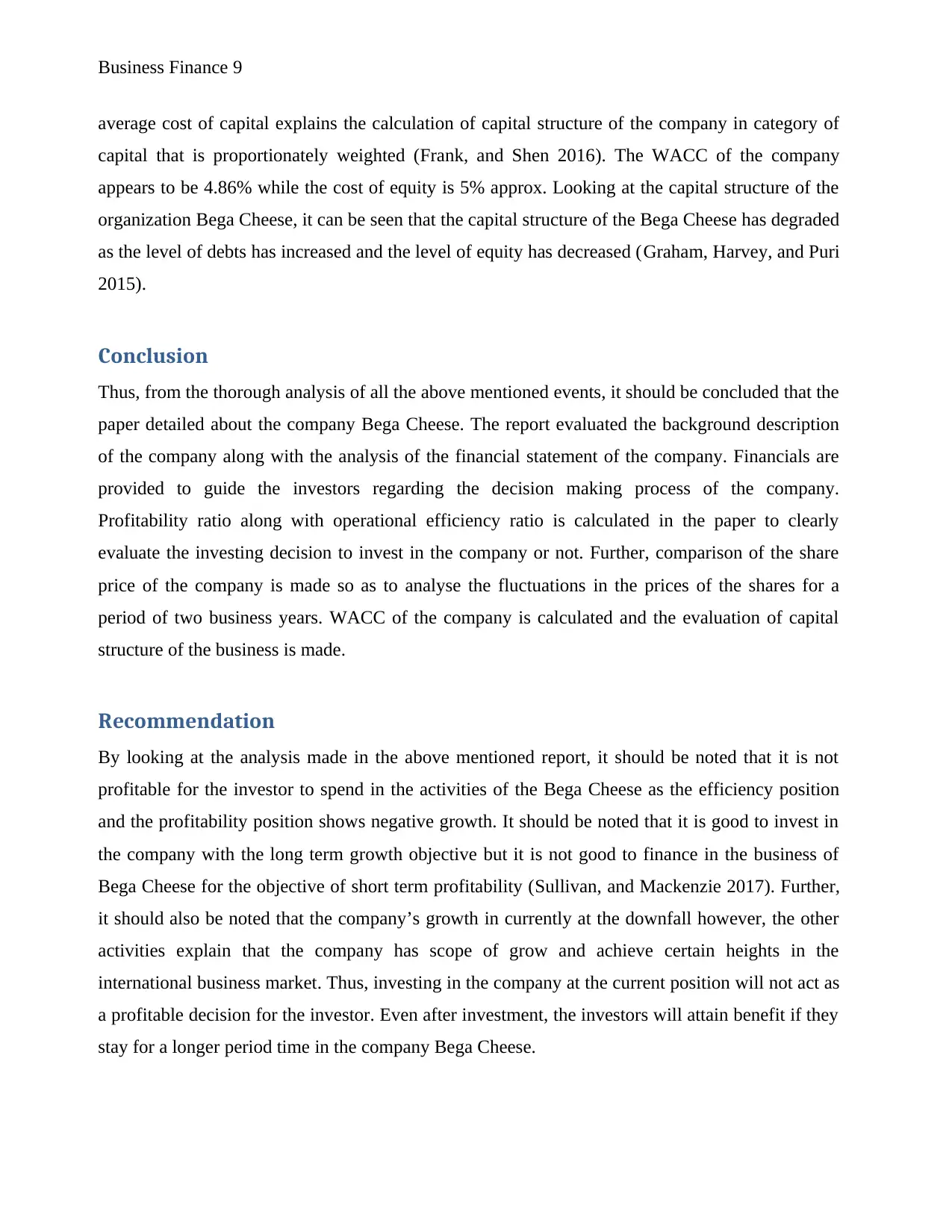
Business Finance 9
average cost of capital explains the calculation of capital structure of the company in category of
capital that is proportionately weighted (Frank, and Shen 2016). The WACC of the company
appears to be 4.86% while the cost of equity is 5% approx. Looking at the capital structure of the
organization Bega Cheese, it can be seen that the capital structure of the Bega Cheese has degraded
as the level of debts has increased and the level of equity has decreased (Graham, Harvey, and Puri
2015).
Conclusion
Thus, from the thorough analysis of all the above mentioned events, it should be concluded that the
paper detailed about the company Bega Cheese. The report evaluated the background description
of the company along with the analysis of the financial statement of the company. Financials are
provided to guide the investors regarding the decision making process of the company.
Profitability ratio along with operational efficiency ratio is calculated in the paper to clearly
evaluate the investing decision to invest in the company or not. Further, comparison of the share
price of the company is made so as to analyse the fluctuations in the prices of the shares for a
period of two business years. WACC of the company is calculated and the evaluation of capital
structure of the business is made.
Recommendation
By looking at the analysis made in the above mentioned report, it should be noted that it is not
profitable for the investor to spend in the activities of the Bega Cheese as the efficiency position
and the profitability position shows negative growth. It should be noted that it is good to invest in
the company with the long term growth objective but it is not good to finance in the business of
Bega Cheese for the objective of short term profitability (Sullivan, and Mackenzie 2017). Further,
it should also be noted that the company’s growth in currently at the downfall however, the other
activities explain that the company has scope of grow and achieve certain heights in the
international business market. Thus, investing in the company at the current position will not act as
a profitable decision for the investor. Even after investment, the investors will attain benefit if they
stay for a longer period time in the company Bega Cheese.
average cost of capital explains the calculation of capital structure of the company in category of
capital that is proportionately weighted (Frank, and Shen 2016). The WACC of the company
appears to be 4.86% while the cost of equity is 5% approx. Looking at the capital structure of the
organization Bega Cheese, it can be seen that the capital structure of the Bega Cheese has degraded
as the level of debts has increased and the level of equity has decreased (Graham, Harvey, and Puri
2015).
Conclusion
Thus, from the thorough analysis of all the above mentioned events, it should be concluded that the
paper detailed about the company Bega Cheese. The report evaluated the background description
of the company along with the analysis of the financial statement of the company. Financials are
provided to guide the investors regarding the decision making process of the company.
Profitability ratio along with operational efficiency ratio is calculated in the paper to clearly
evaluate the investing decision to invest in the company or not. Further, comparison of the share
price of the company is made so as to analyse the fluctuations in the prices of the shares for a
period of two business years. WACC of the company is calculated and the evaluation of capital
structure of the business is made.
Recommendation
By looking at the analysis made in the above mentioned report, it should be noted that it is not
profitable for the investor to spend in the activities of the Bega Cheese as the efficiency position
and the profitability position shows negative growth. It should be noted that it is good to invest in
the company with the long term growth objective but it is not good to finance in the business of
Bega Cheese for the objective of short term profitability (Sullivan, and Mackenzie 2017). Further,
it should also be noted that the company’s growth in currently at the downfall however, the other
activities explain that the company has scope of grow and achieve certain heights in the
international business market. Thus, investing in the company at the current position will not act as
a profitable decision for the investor. Even after investment, the investors will attain benefit if they
stay for a longer period time in the company Bega Cheese.
Paraphrase This Document
Need a fresh take? Get an instant paraphrase of this document with our AI Paraphraser

Business Finance 10
References
Baker, M. and Wurgler, J., 2015. Do strict capital requirements raise the cost of capital? Bank
regulation, capital structure, and the low-risk anomaly. American Economic Review, 105(5),
pp.315-20.
Bega Cheese., (2018) Annual Report [online]. Retrieved from <
https://www.begacheese.com.au/investors/annual-reports/ > [accessed on 28 May 2019].
Bega Cheese., (2019) Bega [online]. Retrieved from <
https://www.begacheese.com.au/careers/values// > [accessed on 28 May 2019].
Berger, P.G., Chen, H.J. and Li, F., 2018. Firm specific information and the cost of equity
capital. Feng, Firm Specific Information and the Cost of Equity Capital (April 2, 2018).
Bloomberg, (2018) Company Overview of Bega Cheese Limited. Retrieved at:
https://www.investing.businessweek.wallst.com/research/stocks/snapshot/snapshot_article.asp?
ticker=BGA:AU accessed on 28 May 2019.
Collier, P.M., 2015. Accounting for managers: Interpreting accounting information for decision
making. John Wiley & Sons.
Foster, G., 2004. Financial Statement Analysis, 2/e. Pearson Education India.
Frank, M.Z. and Shen, T., 2016. Investment and the weighted average cost of capital. Journal of
Financial Economics, 119(2), pp.300-315.
Fridson, M.S. and Alvarez, F., 2011. Financial statement analysis: a practitioner's guide (Vol.
597). John Wiley & Sons.
Grace, M.F., Leverty, J.T., Phillips, R.D. and Shimpi, P., 2015. The value of investing in enterprise
risk management. Journal of Risk and Insurance, 82(2), pp.289-316.
Graham, J.R., Harvey, C.R. and Puri, M., 2015. Capital allocation and delegation of decision-
making authority within firms. Journal of Financial Economics, 115(3), pp.449-470.
References
Baker, M. and Wurgler, J., 2015. Do strict capital requirements raise the cost of capital? Bank
regulation, capital structure, and the low-risk anomaly. American Economic Review, 105(5),
pp.315-20.
Bega Cheese., (2018) Annual Report [online]. Retrieved from <
https://www.begacheese.com.au/investors/annual-reports/ > [accessed on 28 May 2019].
Bega Cheese., (2019) Bega [online]. Retrieved from <
https://www.begacheese.com.au/careers/values// > [accessed on 28 May 2019].
Berger, P.G., Chen, H.J. and Li, F., 2018. Firm specific information and the cost of equity
capital. Feng, Firm Specific Information and the Cost of Equity Capital (April 2, 2018).
Bloomberg, (2018) Company Overview of Bega Cheese Limited. Retrieved at:
https://www.investing.businessweek.wallst.com/research/stocks/snapshot/snapshot_article.asp?
ticker=BGA:AU accessed on 28 May 2019.
Collier, P.M., 2015. Accounting for managers: Interpreting accounting information for decision
making. John Wiley & Sons.
Foster, G., 2004. Financial Statement Analysis, 2/e. Pearson Education India.
Frank, M.Z. and Shen, T., 2016. Investment and the weighted average cost of capital. Journal of
Financial Economics, 119(2), pp.300-315.
Fridson, M.S. and Alvarez, F., 2011. Financial statement analysis: a practitioner's guide (Vol.
597). John Wiley & Sons.
Grace, M.F., Leverty, J.T., Phillips, R.D. and Shimpi, P., 2015. The value of investing in enterprise
risk management. Journal of Risk and Insurance, 82(2), pp.289-316.
Graham, J.R., Harvey, C.R. and Puri, M., 2015. Capital allocation and delegation of decision-
making authority within firms. Journal of Financial Economics, 115(3), pp.449-470.
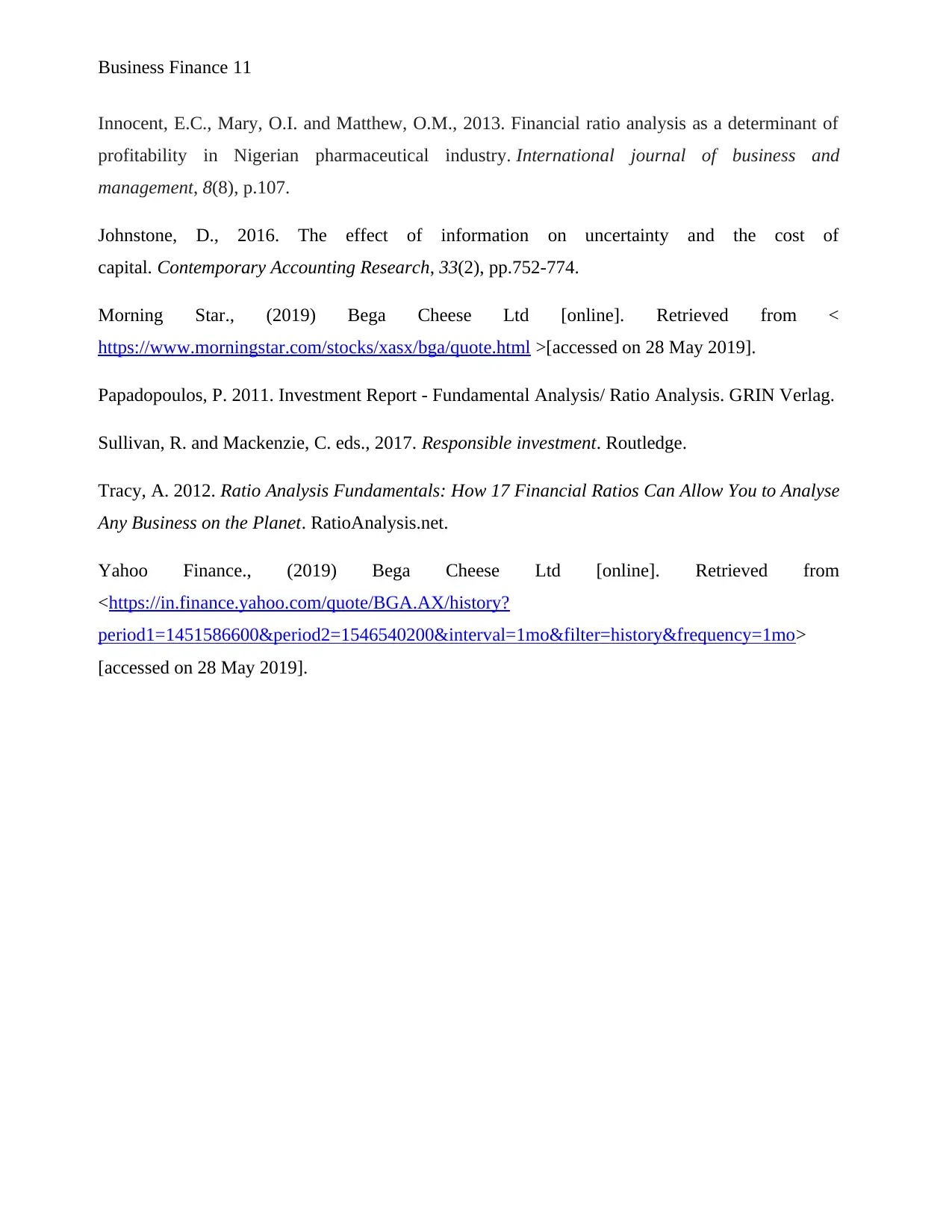
Business Finance 11
Innocent, E.C., Mary, O.I. and Matthew, O.M., 2013. Financial ratio analysis as a determinant of
profitability in Nigerian pharmaceutical industry. International journal of business and
management, 8(8), p.107.
Johnstone, D., 2016. The effect of information on uncertainty and the cost of
capital. Contemporary Accounting Research, 33(2), pp.752-774.
Morning Star., (2019) Bega Cheese Ltd [online]. Retrieved from <
https://www.morningstar.com/stocks/xasx/bga/quote.html >[accessed on 28 May 2019].
Papadopoulos, P. 2011. Investment Report - Fundamental Analysis/ Ratio Analysis. GRIN Verlag.
Sullivan, R. and Mackenzie, C. eds., 2017. Responsible investment. Routledge.
Tracy, A. 2012. Ratio Analysis Fundamentals: How 17 Financial Ratios Can Allow You to Analyse
Any Business on the Planet. RatioAnalysis.net.
Yahoo Finance., (2019) Bega Cheese Ltd [online]. Retrieved from
<https://in.finance.yahoo.com/quote/BGA.AX/history?
period1=1451586600&period2=1546540200&interval=1mo&filter=history&frequency=1mo>
[accessed on 28 May 2019].
Innocent, E.C., Mary, O.I. and Matthew, O.M., 2013. Financial ratio analysis as a determinant of
profitability in Nigerian pharmaceutical industry. International journal of business and
management, 8(8), p.107.
Johnstone, D., 2016. The effect of information on uncertainty and the cost of
capital. Contemporary Accounting Research, 33(2), pp.752-774.
Morning Star., (2019) Bega Cheese Ltd [online]. Retrieved from <
https://www.morningstar.com/stocks/xasx/bga/quote.html >[accessed on 28 May 2019].
Papadopoulos, P. 2011. Investment Report - Fundamental Analysis/ Ratio Analysis. GRIN Verlag.
Sullivan, R. and Mackenzie, C. eds., 2017. Responsible investment. Routledge.
Tracy, A. 2012. Ratio Analysis Fundamentals: How 17 Financial Ratios Can Allow You to Analyse
Any Business on the Planet. RatioAnalysis.net.
Yahoo Finance., (2019) Bega Cheese Ltd [online]. Retrieved from
<https://in.finance.yahoo.com/quote/BGA.AX/history?
period1=1451586600&period2=1546540200&interval=1mo&filter=history&frequency=1mo>
[accessed on 28 May 2019].
⊘ This is a preview!⊘
Do you want full access?
Subscribe today to unlock all pages.

Trusted by 1+ million students worldwide
1 out of 20
Related Documents
Your All-in-One AI-Powered Toolkit for Academic Success.
+13062052269
info@desklib.com
Available 24*7 on WhatsApp / Email
![[object Object]](/_next/static/media/star-bottom.7253800d.svg)
Unlock your academic potential
Copyright © 2020–2025 A2Z Services. All Rights Reserved. Developed and managed by ZUCOL.





